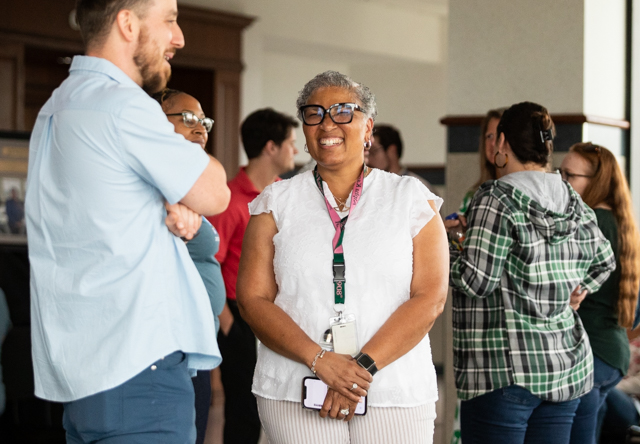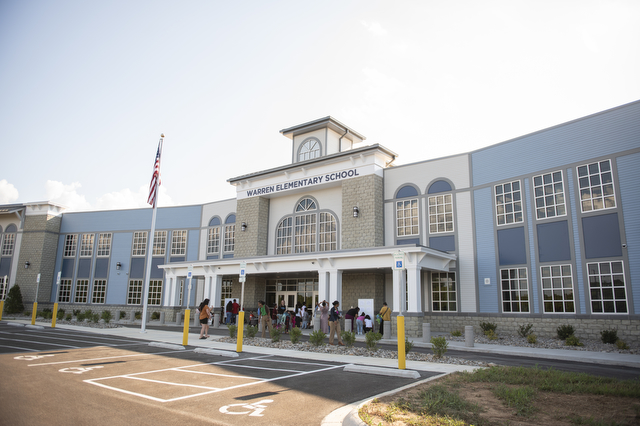Planetarium celebrates 50th anniversary of moon landing
Published 7:00 pm Saturday, July 20, 2019

- People walk through a recreation of the moon landing on Saturday, July 20, 2019, at the WKU. (Austin Anthony/photo@bgdailynews.com)
The Apollo Lunar Module Eagle landed on the moon at 20:17 Coordinated Universal Time on July 20, 1969. At that exact time 50 years later – 3:17 p.m. CDT – a Moon Landing Celebration at Western Kentucky University’s Hardin Planetarium honored the moment when Neil Armstrong said, “Houston, Tranquility Base here. The Eagle has landed.”
This year marks the 50th anniversary of the first moon landing, and Hardin Planetarium – 1501 State St. – hosted a full day of activities Saturday to honor the historic event, including a Bruster’s Real Ice Cream truck, games, challenges, movie screenings, live theater and more from 1 to 10 p.m.
Trending
Richard Gelderman, director of Hardin Planetarium, said he “really wanted” the event to be outside even though it was 93 degrees Fahrenheit and there was an excessive heat warning. Gelderman said his “clearest memory” as a child is linked to the Apollo 11 mission, and he wanted to inspire that same curiosity.
“The very first people who came in all came in – as hot as it is – with smiles on their faces and expectant looks and they’re all curious and thoughtful,” Gelderman said. “It’s everything that I wanted. If we would’ve gone inside in the beautiful air conditioning … it would’ve been isolated and we would’ve lost this festival, carnival feel. The chaos that’s here is regrettable – except where it’s not, except it’s kind of neat energy.”
The day kicked off at 1 p.m. with a screening of “Spider,” which is the fifth episode of the 12-episode HBO series, “From the Earth to the Moon.” Films, “The Dish” and “Apollo 11,” played at 2 and 4:45 p.m., respectively, and two additional episodes of the HBO series were shown at 3:45 and 6:15 p.m.
Eventgoers had the chance to attend the planetarium show, “Max Goes to the Moon,” at 1:30 and 4:15 p.m. The Fountain Square Players also presented an excerpt from their “Footsteps to the Moon” show at 2:45 and 3:30 p.m.
The Hands-On Activity Festival – which Gelderman said was “the heart of this (event) in my mind” – began at 2:30 and lasted until 5 p.m. Kids, parents and people of all ages got to enjoy one-on-one interactions and hands-on learning at 22 different exhibits about space, lunar exploration and rockets.
No admission was charged for any of the day’s events and free parking was available in all WKU lots, which made the day a great fit for Johnathan Barnes, who attended the celebration with Caleb Barnes, 10, and Connor Barnes, 10.
Trending
“I’m always looking for cost-effective events to bring the kids to where you can spend time with ’em and this is something that was educational,” Johnathan Barnes said. “Caleb is interested in astronomy, and so it was a good fit. There’s a wide variety of things to do and see.”
Caleb Barnes said the moon landing celebration was “pretty cool,” while Connor Barnes added that he’d enjoyed a “good time.” Both kids agreed the “fun part” of the event was getting to launch the rockets they’d made into the air. Johnathan Barnes agreed the rockets “absolutely” lived up to the hype.
Johnathan Barnes said his boys also enjoyed walking on a lawn behind WKU’s complex of science buildings. The area, which was filled with flags marking the exact footsteps Neil Armstrong and Buzz Aldrin made on the moon’s surface, also featured representations of the lunar module and the TV camera.
John Wulff, a rising senior at Bowling Green High School, worked as a volunteer at the event. Wulff gave tours and explained the moon walk exhibit, which he said was rewarding because he could see the “wonder” on people’s faces.
“Rockets and everything, it just seemed more interesting to me than things down here,” Wulff said. “I think it’s so cool to be able to see the actual path that they took. Obviously we can’t go to the moon, but this is somewhat close. It’s the closest we can get to seeing what they actually did until we can go back and visit it for ourselves, which maybe we’ll be able to do someday.”
An eventwide moment of glee took place at 3:17 p.m. – paying homage to the Apollo 11 mission’s successful landing on the moon at that time 50 years ago. As an addendum to the cheerful display, Gelderman said 150 Mini Moon Pies were available for patrons on a first-come, first-served basis.
The Rocket Launching Challenge began immediately after the activity festival at 5 p.m. on the lawn behind Snell Hall, located at the corner of 14th Avenue and Chestnut Street. The high-flying rockets were launched using compressed air and chemical propellant, which helped them soar high above the buildings used by WKU’s Ogden College of Science and Engineering.
Two science teachers from Drakes Creek Middle School – Ecil Miller and Zachary Vincent – were in charge of the evening’s launch demonstrations, which was the last outdoor event of the moon landing celebration.
“Rocketry covers all STEM aspects,” Miller said in a pre-event news release. “Students design rockets using software programs, build rockets from scratch, and use calculations to hit target altitudes. While students are doing these things, they are learning classical mechanics. It really is rocket science.”
The Moon Landing Trivia Contest began at 5:45 p.m. in Kelly Thompson Hall before The Fountain Square Players presented the “Footsteps to the Moon” show at 7 p.m. A play by Andrea Brunello, “Fly Me to the Moon,” was presented by Jet Propulsion Theatre in the star chamber at 8:15 p.m.
Gelderman said the final production would officially end the day, but some people would likely stick around until 9:56 p.m. – when in 1969, Armstrong uttered the phrase, “One small step for man, one giant leap for mankind.”
“At almost 10 o’clock is when (Armstrong) was on the round footpad of the lunar module and he finally put that footprint off of a man-made thing and onto the first world – and the only other world – that men have ever stepped on. So, at that point, it’s 10 o’clock at night and we’re saying goodbye.”
Gelderman said the Apollo 11 mission took off July 16, 1969, which was also his birthday. The excitement and anticipation he felt watching the black-and-white images on a TV screen is what inspired him to pursue being an astronaut, which eventually led him to a career teaching astronomy.
No one has stepped on the moon since 1972, which Gelderman feels isn’t right. The 1990s and 2000s were filled with years of empty promises that the United States would eventually go back to the moon, and Gelderman said the event was aimed at getting kids to think about space travel at a young age.
“50 years – man, that’s a long time,” Gelderman said. “I was so young back then. It’s a long time and we haven’t been back (since 1972) yet … now the promise is 2024, but all of this is let’s keep the pressure on, this ought to happen. It is such a big universe and we’re on such a little part of it here and I don’t think of it as abandoning our responsibilities to Earth – I think of it as learning about the universe.”







